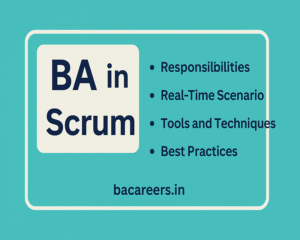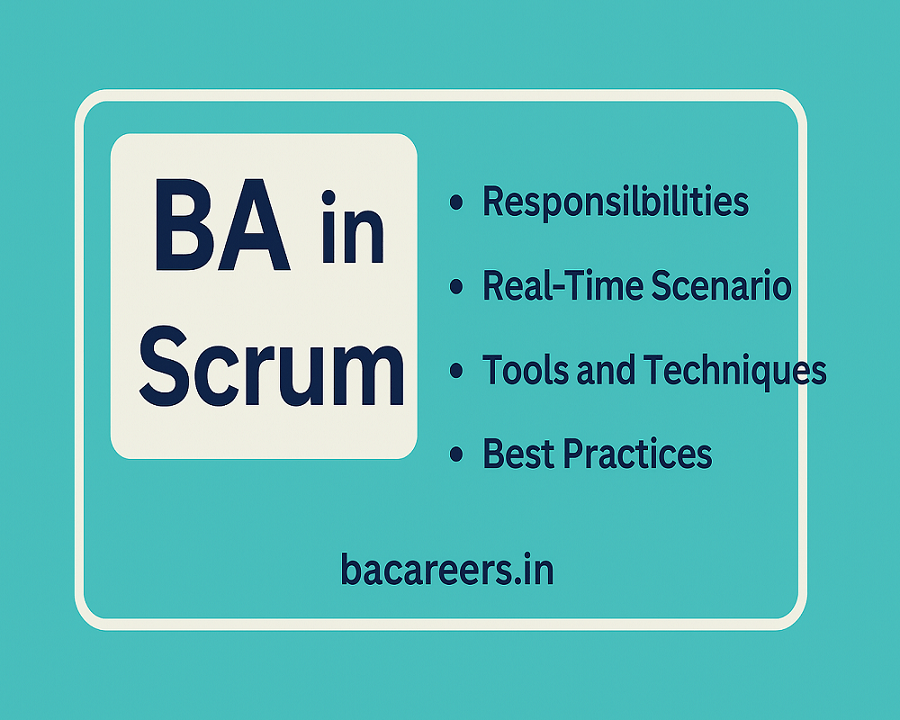Introduction: Understanding BA in Scrum
In traditional software development, the Business Analyst (BA) played a prominent role in gathering and documenting requirements. However, with the rise of Agile and Scrum methodologies, many organizations started questioning the need for a dedicated BA. But in reality, a BA in Scrum plays a vital role in bridging the gap between business and technology, even though Scrum doesn’t explicitly define the role.
In this article, we will explore how a Business Analyst fits into the Scrum framework, what value they add, real-time use cases, and how to align BA responsibilities within Agile ceremonies.

Table of Contents
What is Scrum?
Is there a BA Role in Scrum?
Responsibilities of BA inScrum
Real-Time Scenario of BA in a Scrum Team
BA’s Role in Scrum Ceremonies
Tools and Techniques Used by BA inScrum
Best Practices for BA inScrum
Internal and External Learning Resources
1. What is Scrum?
Scrum is a lightweight Agile framework used to develop, deliver, and sustain complex products. It uses short, iterative development cycles called Sprints, typically lasting 2–4 weeks.
The core roles defined in Scrum are:
Product Owner (PO)
Scrum Master
Development Team
External Link: Learn more from the official Scrum Guide: https://scrumguides.org
2. Is There a BA Role in Scrum?
Scrum does not explicitly define a BA role, but organizations often integrate a BA as part of the Development Team or as a proxy between the Product Owner and Development Team.
✅ Fact: The International Institute of Business Analysis (IIBA) acknowledges the importance of BA in Agile projects through its Agile Extension to the BABOK® Guide.
3. Responsibilities of BA in Scrum
A BA in Scrum adapts their traditional skills to support the team in a flexible, iterative, and collaborative environment.
🔹 Key Responsibilities:
Requirement Elicitation: Work closely with stakeholders and the Product Owner to gather user needs.
User Story Creation: Break down epics into actionable user stories with proper acceptance criteria.
Backlog Refinement: Help the Product Owner maintain and prioritize the product backlog.
Support Development: Clarify business needs to developers and testers during the Sprint.
Facilitate Communication: Act as a bridge between business stakeholders and the Scrum team.
🧠 Real-Time Example: In a banking project, the BA works with the Product Owner to translate a feature like “Loan Approval Workflow” into multiple user stories such as:
“As a Loan Officer, I want to validate customer income, so that I can assess creditworthiness.”
“As a Customer, I want to receive SMS notifications for loan status.”
4. Real-Time Scenario: BA in a Scrum Team
Scenario: Insurance Product Enhancement
Sprint Goal: Enable customers to upload documents for insurance claims.
BA’s Role:
Interact with Claims Department to understand pain points.
Create user stories like: “As a customer, I want to upload claim documents, so I can initiate my claim faster.”
Clarify requirements during Sprint Planning.
Work with QA to define acceptance criteria and test cases.
Outcome: Improved customer satisfaction and reduced claim processing time by 30%.
5. BA’s Role in Scrum Ceremonies
| Scrum Ceremony | BA’s Contribution |
|---|---|
| Sprint Planning | Help PO write clear user stories and define acceptance criteria. |
| Daily Scrum (Stand-up) | Provide clarification on user stories if needed. |
| Sprint Review | Gather feedback from stakeholders and validate functionality. |
| Sprint Retrospective | Share insights on communication gaps and requirements gathering. |
| Backlog Refinement | Split epics, ensure user stories are INVEST-compliant. |
🧰 INVEST: Independent, Negotiable, Valuable, Estimable, Small, Testable
6. Tools and Techniques Used by BA in Scrum
🔧 Common Tools:
JIRA – For managing product backlog and tracking progress
Confluence – For documentation and sharing insights
Miro / Lucidchart – For process modeling and brainstorming
ChatGPT / AI Tools – For refining user stories or brainstorming acceptance criteria
📌 Techniques:
User Story Mapping
5 Whys Analysis
Use Case Diagrams
Process Flows
📖 Related Read: Business Process Modeling Techniques
7. Best Practices for BA inScrum
To be effective in a Scrum environment, a BA should follow these Agile best practices:
✅ Focus on Collaboration
Partner with the Product Owner and Developers early and often.
✅ Embrace Flexibility
Be ready for changing priorities and adapt your analysis accordingly.
✅ Prioritize Value
Ensure that each user story delivers real business value.
✅ Visualize Requirements
Use diagrams, mockups, or flows to simplify complex processes.
✅ Write Testable Acceptance Criteria
Support testers and ensure Definition of Done is clear.
📌 Internal Link: User Story Writing Best Practices
8. Internal and External Learning Resources
🔗 Internal Links:
🌐 External Links:
Conclusion
While Scrum does not mandate a BA role, the Business Analyst remains a critical enabler of Agile success. Their ability to understand business needs, break down complex problems, and collaborate across roles ensures smoother delivery and higher value for customers.
Whether you’re transitioning from Waterfall or looking to strengthen your Agile practices, BAs inScrum are indispensable.

Business Analyst , Functional Consultant, Provide Training on Business Analysis and SDLC Methodologies.

